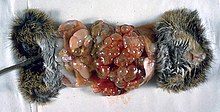Echinococcus
| Echinococcus | |
|---|---|
 |
|
| Scientific classification | |
| Kingdom: | Animalia |
| Phylum: | Platyhelminthes |
| Class: | Cestoda |
| Order: | Cyclophyllidea |
| Family: | Taeniidae |
| Genus: | Echinococcus |
The genus Echinococcus includes six parasite species of cyclophyllid tapeworms to date, of the family Taeniidae. Infection with Echinococcus results in hydatid disease, also known as echinococcosis.
Echinococcus is triploblastic – it has three layers – outermost ectoderm, middle mesoderm, and inner endoderm. An anus is absent, and it has no digestive system. Its body is covered by tegument and the worm is divided into a scolex, a short neck, and three to six proglottids. Its body shape is ribbon-like.
In humans, this causes a disease called echinococcosis. The three types of echinococcosis are cystic echinococcosis caused by E. granulosus, alveolar echinococcosis caused by E. multilocularis, and polycystic echinococcosis caused by E. vogeli or E. oligarthrus. A worm's incubation period is usually long and can be up to 50 years. Cystic echinococcosis is mostly found in South and Central America, Africa, the Middle East, China, Italy, Spain, Greece, Russia, and the western United States (Arizona, New Mexico, and California).
Echinococcosis is a zoonosis. The definitive hosts are carnivorous predators – dogs, wolves, foxes, and lions. The adult tapeworm lives in their small intestines and delivers eggs to be excreted with the stool. The intermediate hosts are infected by ingesting eggs. Sheep, goats, cattle, camels, pigs, wild herbivores, and rodents are the usual intermediate hosts, but humans can also be infected. Humans are dead-end hosts, since their corpses are nowadays seldom eaten by carnivorous predators.
...
Wikipedia
